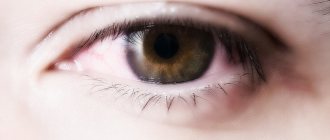If you have experienced flickering before your eyes only a few times, do not worry or worry. But if glare often appears in your eyes, you should pay special attention to your health and consult a specialist. Because such a manifestation may signal the presence of a serious illness.
The reasons why dots, spots, and flashes flash before your eyes can be very diverse. So, for example, flickering in the eyes with cervical osteochondrosis is one of the signs of the manifestation of this disease.
In this article we propose to consider the main reasons for the appearance of flicker and glare.
Flickering in the eyes, reasons:
An alarming sign is bright flashes that repeat constantly. If they are accompanied by severe migraine, tinnitus and dizziness, visit the clinic immediately for consultation with a doctor. Since these symptoms signal the beginning of destructive processes in the body.
There are many reasons why “bunnies” appear before your eyes. Almost all of them are associated with a malfunction of the central nervous system. The pathology is accompanied by poor circulation, which leads to increased blood pressure and causes problems in the functioning of internal organs.
Most often, glare is caused by a disruption in blood circulation and an increase in intracranial pressure. In this case, the patient observes black and white dots in front of his eyes. Also, “bunnies” can be caused by overflow of the blood vessels of the visual apparatus.
In addition, the manifestation of unpleasant symptoms is caused by:
- Lack of vitamins, anorexia, exhausting diets;
- Hypertension or hypotension. In this case, in addition to glare, a person observes floating dots and darkening;
- Consumption of large quantities of alcoholic beverages and tobacco products;
- Problems with the spine. The appearance of “flies” signals pinching of nerve endings and blood vessels, and a disruption in blood flow occurs. As a result, not only the eyes, but also the spinal cord are affected;
- Anemia. Flickering is observed regularly;
- Damage to the organ of vision;
- Emotional overload, stress;
- Intoxication;
- Hemarthrosis in the brain. In this case, a person observes “fly spots” flashing before his eyes, which portends a loss of consciousness;
- Increased blood sugar levels. Severe diabetes affects the vascular system;
- Trauma of the skull;
- Internal bleeding.
| Glare in the eyes can be observed in pregnant women. This is a very dangerous symptom that can harm the health of the expectant mother and baby, so immediately consult a doctor for a comprehensive examination. |
“Bunnies” may appear after prolonged exposure to the sun. They are the first sign of sunstroke.
Hypertension as a cause
If a patient constantly suffers from high blood pressure, then he is at risk of people prone to stroke and other emergency conditions, for example, a hypertensive crisis. If ripples begin in the eyes, and then an intense headache forms, then this is a harbinger of a dangerous condition. In this case, the pain is pulsating in nature, located mainly in the occipital region.
Visually, a person sees how the eyes dazzle in the form of “flies”. Vision decreases greatly, the background darkens. With severe hypertension, nausea, sleep problems and other serious disorders occur.
The disease must be treated using different medications. But without eliminating the cause, it will not be possible to get rid of persistent symptoms. Antihypertensive drugs and diuretics are often prescribed, and the patient’s lifestyle is changed.
What diseases have this symptom?
Lightning and patterns before the eyes signal the development of a number of pathologies:
- High blood pressure. In this case, a spasm of the vascular system located in the retina of the organ of vision is observed. Hemarthrosis occurs, which disrupts eye function;
- Low pressure. Not enough oxygen enters the vascular system, which causes glare;
- Cervical osteochondrosis. Displacement of the vertebrae leads to pinched nerve endings, they do not receive enough blood;
- Reduced hemoglobin level. Anemia causes dizziness, constant flickering and vision problems;
- Increased sugar content in the circulatory system. As a result, the retina of the eye is affected and glare appears;
- Ophthalmological pathologies. The cause of “bunnies” can be cataracts or glaucoma;
- Migraine. Bright flashes are heralds of a severe headache;
- Eclampsia. The disease is diagnosed in pregnant women in late stages. If the first symptoms of pathology occur, immediately contact the clinic. The disease poses a threat to the health of the expectant mother and her baby;
- Lack of vitamins. To eliminate unpleasant symptoms, balance your diet and take a vitamin course;
- Poisoning of the body. In this case, damage occurs to the nerves located in the visual apparatus.
Only a doctor can identify the disease that caused the glare after carrying out a series of diagnostic measures. Return to contents
What ophthalmic diseases cause flicker?
These pathologies include:
- Myopia;
- Swelling of the cornea. As a result, the nerve endings of the organ of vision are compressed and small vessels are damaged;
- Mechanical eye injury;
- Inflammation of the uveal tract;
- Deviations in the retina, causing its detachment;
- Destruction of the vitreous body. The moisture contained inside the eye changes its consistency and becomes more liquid. The eye tissue also thickens and shrinks;
- Cataracts or glaucoma can cause the anomaly.
| An ophthalmologist will be able to diagnose a disease that causes the regular appearance of glare after an examination. |
Other diseases
Lightning, bright flashes, and “bunnies” are often not associated with the development of eye pathologies. For example, oscillopsia causes unpleasant symptoms. In this case, glare appears if you turn your head sharply or change your body position.
Problems with the spine can also provoke the appearance of flickering. Visual acuity and the functioning of the vestibular apparatus are directly related to the functioning of the vertebral arteries. Their pinching is accompanied by the following signs:
- Side glare that slowly spreads across the entire visual field;
- The appearance of white dots, temporary blindness;
- Increased flicker;
- Increased blood pressure.
| The doctor will be able to determine the cause of the bright flashes after a visual examination and collection of the necessary tests. |
What happens to the eyes
Flicker is a loss of clarity of vision, causing the contours of objects to blur. It is often accompanied by:
- bright flashes;
- glare;
- white or black flies;
- migraines;
- dizziness.
Sometimes it all starts in the right (or left) eye. A flickering spot appears on the side of the periphery, which then moves to the second visual organ. For a person who has never encountered anything like this, such “light music” can be very frightening, but there is no need to worry prematurely. Try to figure out what is causing the anomaly. Usually it is enough to observe yourself for a while and the situation will become clearer.
So, if the problem begins to bother you in the evening and goes away after a walk or rest, then simple fatigue is to blame. It's easy to heal here:
- try to go to bed early;
- drink soothing tinctures (lemon balm, motherwort, valerian, mint, etc.);
- give up coffee;
- as a last resort, take a vacation.
Flickering and headache
There are several factors that cause this symptomatology:
- Ophthalmological pathologies;
- Osteochondrosis;
- Problems with the heart and blood vessels;
- Psycho-emotional stress;
- Migraine.
If the visual apparatus malfunctions, the headache becomes stronger if you turn around sharply. Also, unpleasant sensations are intensified by loud sounds and bright lights. Additionally, signs such as increased lacrimation, pain in the temples and back of the head, dizziness, weakness and drowsiness are observed. Taking painkillers will help you feel better.
Symptoms of ocular migraine
Like any disease, atrial scotoma has characteristic symptoms, which can be divided into those characteristic of classic migraine and special ones characteristic directly of the ocular form.
So, the classic symptoms:
- severe throbbing headache, which is localized on one side of the head (bilateral migraine is less commonly diagnosed);
- nausea;
- vomit;
- reaction to bright lights and loud sounds;
- temperature.
Special symptoms:
- glare and white spots in front of the patient’s eyes (these spots may gradually increase in size);
- flickering before the eyes;
- temporary blindness;
visual hallucinations.
Retinal migraine may be accompanied by:
- temporary or permanent blindness;
- severe nausea and vomiting.
Ophthalmoplegic migraine, in turn, has the following symptoms
- damage to the oculomotor nerve (strabismus, asymmetry of the pupils, ptosis);
Ptosis - involuntary drooping of the lower eyelid
- retinal damage;
- internal or external ophthalmoplegia.
Ophthalmoplegia - damage or numbness of the visual muscles
Decreased visual acuity
Long-term nature of special symptoms (they may persist after the end of the aura phase, and even persist for a longer period - up to several weeks)
There is another form of ocular migraine - acephalgic migraine. This is a type of illness in which there are no classic symptoms and only special ones are present. This type of migraine is also called “decapitated”.
In most cases, this disease develops in children and adolescents due to hormonal changes in the body. In addition, there is a lot of evidence of the development of atrial scotoma in females who spend a long time in front of the monitor.
Twinkle in the eyes from the side
A similar anomaly is often observed in women after forty years, it is during this period that menopause most often occurs. Also, girls expecting a child may notice side flickering. The reason lies in the adjustment of hormonal levels. During this period, all internal organs and systems undergo changes.
Detachment of the posterior limiting membrane or its destructive pathologies can cause “bunnies”.
If you are concerned about side flicker, measure your blood pressure. In some cases, similar symptoms are observed if the eyes are closed. The cause of the development of the anomaly is hypertension, as a result of which blood circulation in the vascular system of the organ of vision is disrupted. Return to contents
Conclusion
Why is my vision blurry? The cause may be serious chronic pathologies, eye diseases, infections, physiological conditions and the influence of external factors.
If your vision becomes blurry after exercising, due to hunger or fatigue, your visual function will be restored after resting and eating a snack.
But if you are sick with a serious illness, your vision has deteriorated sharply, your eyes see cloudy, the image is constantly blurry - be sure to visit an ophthalmologist and get examined!
Features of treatment
The doctor should select therapy after carrying out all diagnostic measures. The main purpose of treatment is to eliminate the cause that caused the appearance of “bunnies” before the eyes. If the “root of evil” lies in a malfunction of the internal organs, medications are selected to combat the disease. If the cause is hidden in ophthalmic ailments, you will need to undergo a course of therapy, including:
- For three months, use a 1% solution of Emoxipin three times a day. It strengthens the blood vessels of the eye, normalizes the circulation of intraocular fluid, and provides the retina with protection from harmful ultraviolet radiation;
- For two weeks, take Wobenzym three times a day. It blocks inflammation, provides tissues with necessary substances, eliminates pain;
- Take a course of vitamins containing lutein;
- Homeopathic substances are useful: ustigalo, crocus, etc.
As an addition to therapy, the doctor can select a special diet, which is based on the exclusion of harmful foods from the diet.
Osteochondrosis
One of the causes of unpleasant factors that appear like ripples and headaches is cervical osteochondrosis, caused by excess weight, lack of physical activity and an unhealthy lifestyle:
- the vertebrae begin to change structure;
- their position gradually shifts;
- intervertebral discs are destroyed;
- nerves and blood vessels are compressed;
- severe deformation develops.
All this leads to poor brain function, deterioration of cognitive functions, and oxygen starvation.
Preventive measures to improve vision
There are several simple recommendations that will prevent the appearance of “bunnies” before your eyes:
- Create a balanced diet. The body must receive the required amount of proteins, fats and carbohydrates every day. Include fresh herbs, nuts, fruits and vegetables in your menu. If possible, consult a nutritionist, he will help you choose the optimal diet;
- Give your eyes rest and avoid overstrain. This is especially true for those who spend a lot of time at the computer. Take a break every hour, and during moments of rest, do simple gymnastics;
- Gather your willpower and give up bad habits. They negatively affect the health of not only the eyes, but also the entire body;
- Take medications after consulting a doctor;
- Play sports and walk more in the fresh air;
- On a sunny day, do not go outside without protective equipment;
- Sleep at least eight hours a day and avoid stress.
| Flickering in the eyes is an unpleasant symptom, but if you follow simple preventive measures, you can avoid its manifestation and minimize the risk of developing various pathologies. |
Prevention
Remember! To avoid flickering, you must follow these recommendations:
- monitor blood pressure if hypertension is diagnosed;
- regularly undergo preventive examinations of the body ;
- maintain a sleep and rest schedule;
- eat more fruits, vegetables, cereals;
- take a rest break every hour ;
- In summer, protect your eyes with sunglasses.
Arterial pressure
Darkening and dots before the eyes occur during a sharp surge in pressure. This happens in healthy people if:
- Make sudden movements;
- Stay upside down for a long time;
- Quickly change body position.
The blurry vision is explained by a sharp increase in pressure, arterial and ocular. You should measure your blood pressure and lie quietly for a couple of minutes. During this time, the pressure will normalize and vision will be restored.
If rest does not help, the cause of blurred vision may be cardiovascular pathologies:
- Arterial hypertension;
- Hypotension;
- Vasospasm;
- Dysfunction of the autonomic nervous system;
- Anemia.
Glucose level
Diabetes mellitus is one of the causes of decreased vision. The risk of developing eye diseases occurs during periods of high blood sugar. The patient's vision becomes cloudy due to swelling of the lens.
To restore visual function, it is necessary to normalize glucose levels.
People with diabetes should visit an eye doctor regularly. Sometimes such patients have blurred vision due to concomitant diseases:
- Retinopathy (progressive damage to the retina);
- Intraocular pressure;
- Cataract.
These pathologies are dangerous due to decreased or loss of vision.
To prevent the development of complications, people with diabetes are required to monitor the following indicators:
- Blood sugar;
- Cholesterol;
- Arterial pressure.
The problem occurs in people who engage in sports and heavy physical labor. A decrease in blood sugar after exercise is accompanied by dizziness and the appearance of black spots before the eyes.
Visual function is completely restored, additional symptoms disappear after rest and a carbohydrate snack.
A person's illness appears in the dark
Many patients at an ophthalmologist's appointment talk about the appearance of flashes and lightning before their eyes when they are in a dark room. To determine the possible causes of the symptom, a thorough diagnosis will be required. After all, a violation is not always the result of some pathology.
If flickering appears in the dark and disappears after a few seconds, while no other negative signs are observed, the symptom is not considered a violation.
In this situation, the phenomenon is due to:
- fatigue of the visual organs;
- the reaction of the retina to a sudden change in lighting.
Flickering in the eyes, which makes itself felt in the dark, is accompanied by a large number of diseases, among which there are also ophthalmological ailments.
Glare can be a concern if:
- Vascular diseases. If a patient is diagnosed with hypertension or diabetes, flashes in the eyes are a fairly common symptom that is disturbing not only as a result of changes in lighting, but also when the eyes are closed. This indicates short-term spasms and impaired blood flow in the retina.
- Loss of retinal integrity and detachment. If flickering begins to bother you, it means that the retina has begun to peel off.
- Vitreous detachment. Flickers before the eyes usually when the eyeballs move.
- Migraine. Before attacks accompanied by severe headaches, photopsia appears. It is sometimes present without pain.
Only a qualified specialist can make an accurate diagnosis and, if necessary, draw up a treatment plan.









